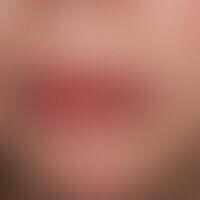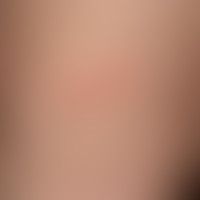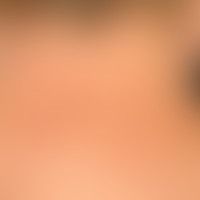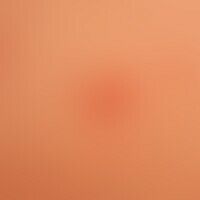Image diagnoses for "Plaque (raised surface > 1cm)", "red"
423 results with 1872 images
Results forPlaque (raised surface > 1cm)red

Erythema migrans A69.2
Erythema chronicum migrans, painless, sharply defined, round, red plaque with centrally located yellowish papule (tick bite), existing for 14 days.

Sweet syndrome L98.2
Dermatosis, acute febrile neutrophils (Sweet syndrome): acutely occurring (existing since 1 week) highfebrile exanthema with involvement of the trunk, face and capillitium as well as the upper extremities. feeling of illness, myalgia, arthritis. high inflammation parameters. cause unknown (viral infection in combination with the intake of anti-inflammatory drugs?).

Psoriasis capitis L40.8
Psoriasis capitis: diffuse reddening of the entire capillitium with coarse lamellar scaling. Here in a 42-year-old patient with extensive psoriasis of the entire integument. Typically, the changes exceed the forehead-hairline.

Congestive dermatitis I83.1
stasis dermatitis: flat, sharply limited plaque of the entire right lower leg. lipofasciosclerosis in case of a previously known CVI with beginning papillomatosis cutis lymphostatica. condition after leg ulcer. currently distinct exudation, lymphorrhoea as well as secondary bacterial colonization.

Drug effect adverse drug reactions (overview) L27.0

Sarcoidosis of the skin D86.3
Sarcoidosis: anular or circulatory chronic sarcoidosis of the skin. persisting for several years. onset with small symptomless papules with continuous appositional growth and central healing. no detectable systemic involvement.

Stevens-johnson syndrome L51.1
Stevens-Johnson syndrome: acute, extensive, painful erosions of the red of the lips, the lip mucosa, the tongue and the gingiva in an 18-year-old woman.

Erythema anulare centrifugum L53.1
Erythema anulare centrifugum: Characteristic single cell lesion with peripherally progressive plaque, which flattens centrally and is only recognizable here as a non raised red spot.

Lupus erythematodes chronicus discoides L93.0
Lupus erythematodes chronicus discoides : Solitary blurred plaque with atropical surface, adherent scaling, bizarrely configured scarring (bright areas); distinct painfulness in case of punctiform exposure (e.g. brushing over with fingernail); unpleasant burning sensation when exposed to UV light.

Lupus erythematosus tumidus L93.2
lupus erythematodes tumidus: chronic, relapsing disease pattern that has been active for months, completely without symptoms; succulent, surface-smooth, red plaques. high sensitivity to light. no hyperesthesia. ANA: negative; DIF: uncharacteristic. good response to antimalarial therapy.

Inverted psoriasis L40.83
Psoriasis inversa: 69-year-old woman. 6 months at presentation. no manifestations of psoriasis present on the remaining integument. family history but positive: son with known psoriasis vulgaris.

Cutaneous mastocytoma Q82.2
Mastocytomas, cutaneous: moderately consistency-propagated, brownish-reddish, blurred, maculopapular plaques; the Darian sign is positive (development of a wheal after rubbing the efflorescence).

Lupus erythematosus subacute-cutaneous L93.1
Lupus erythematosus, subacute-cutaneous, multiple, chronically dynamic, increasing, small or extensive red spots as well as red, small, sometimes rough, scaly papules and pustules on the face of a 66-year-old man. Furthermore, extensive, net-like branched telangiectasia can be found. DIF from lesional skin (see inlet; arrows indicate IgG deposits on the dermo-epidermal basement membrane zone and the follicular epithelium)

Mucinosis cutaneous (overview) L98.5
mucinosis(s). plaque-shaped, idiopathic, cutaneous mucinosis. red, rather sharply defined, cushion-like, smooth plaques in the face of a 42-year-old woman. similar efflorescences were observed in the breast area and on the back.

Acrodermatitis continua suppurativa L40.2
Acrodermatitis continua suppurativa: chronic, recurrent, sterile pustular disease of the acromion, which leads to atrophy and loss of nails if it occurs repeatedly and persists for a long time (see figure).

Nevus verrucosus Q82.5
Bilateral naevus verrucosus in an infant. No symptoms. Psoriasiform aspect of the plaques running in the Blaschko lines, scattered, reddish, slightly infiltrated, scaly.

Erythroplasia queyrat D07.4
DD Erythroplasia: Balanitis plasmacellularis: For 1.5 years recurrent, in the meantime also healing, multiple, temporarily burning, red, rough, sharply defined, velvety granulated plaques on the glans penis in a 53-year-old patient. slight urinary incontinence.

Acrodermatitis chronica atrophicans L90.4
Acrodermatitis chronica atrophicans: extensive, oedematous, tender red erythema as well as flaccid atrophy with cigarette-paper-like folding of the skin on the right hand of a 77-year-old woman. For 2 years there has also been joint pain in both hands and both shoulder joints as well as gait insecurity with proven neuroborreliosis. The fingernails are partly dystrophic (see stripy leukonychia) and partly no longer firmly connected to the nail bed.

Squamous cell carcinoma of the skin C44.-
Squamous cell carcinoma of the skin: ulcerated, temporarily painful and burning, erosive plaque on lichen sclerosus et atrophicus, which has been present for years (still clinically detectable).

Squamous cell carcinoma of the skin C44.-
Squamous cell carcinoma of the skin: carcinoma of the nail bed, which was misjudged as a fungal disease of the toenail and whose infiltrating growth had led to an almost complete onychodystrophy.

Suppurative hidradenitis L73.2
Hidradenitis suppurativa. chronic scarring stage, infiltrated intergrown strands and abscesses in the armpit area.

Contact dermatitis allergic L23.0
Acute contact allergic eczema: typical of the allergic pathogenesis of eczema is the blurred, scattered limitation of the inflammatory zone.


